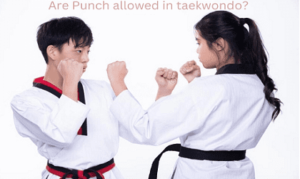Punch in taekwondo (Best Taekwondo Techniques)
In Punch Taekwondo, kicks and punches to the body are allowed. However, kicking below the opponent’s head or below the waist is prohibited. Punch that do not follow the rules result in the taekwondo fighter being awarded points.
This article examines whether punches are allowed in taekwondo, whether there are punches in Olympic taekwondo, and what punches are allowed in taekwondo. It also explains why punches to the head are not allowed in sparring.
Are Punch allowed in taekwondo?

In general, punches are not allowed in taekwondo. According to most rules, it is considered an offense because it is dangerous and unfair. However, some rules allow it under certain circumstances.
In cases where kicking is prohibited, the Punch taekwondo fighter is penalized with a point deduction. It doesn’t take much skill to push someone, does it?
The concept of proficiency in taekwondo rivalry methods is unrelated to this, too. It is dangerous and unacceptable to push an opponent during the initiation and execution of an attack.
For the record, it is important to know that in the original form of taekwondo, there were no strict rules. The major goal was to refine the method.
There were no rules like those that usually exist in competitions and the Olympics.
Therefore, the rules had to be relatively modern and cover a lot of ground, so that the fighters would know what was allowed and what was not, and the judges could determine the winner “objectively”.
The main reasons for banning striking are safety reasons and the incompatibility of striking with this martial art which is based mainly on kicking and punching.
If legalize, there is a risk that stabbing will be abuse as an effective counterattack. Martial arts and other sports that share ties with it regularly make fun of this.
Stabbing is an excellent method of self-defense. If self-defense is the goal, then taekwondo is not an ideal choice.
Taekwondo also features several powerful punches that may be utilize to destroy adversaries. However, it is very difficult for a taekwondo fighter to use punches in a street fight if he or she is not confident in his or her abilities.
A certain amount of divide must be left.
If a kickboxer makes a mistake and falls, something worse can happen! A frantic kickboxer will not give you the opportunity to go down.
If you are facing an incompetent fighter, you still have a chance, even if you only know the sports version of martial arts. However, if you don’t deviate from the rules you’ve always followed, you can’t be sure you can beat your opponent.
Are punching allowed in Olympic Taekwondo?
Kicking is allow in Olympic Taekwondo. However, like many other modern forms of taekwondo, punches are only allowed on the upper body, not on the head or below the belt.
The main differences between Olympic Taekwondo and traditional Taekwondo are the use of head guards, electronic head kicks, and high points for spinning kicks.
Taekwondo practitioners in the 1970s and 1980s were probably able to use punches to the head and elbow strikes. Taekwondo has changed a lot since then, and these changes have sometimes become infamous.
Taekwondo is based on the use of punches and punches.
The punches and kicks arrive with the feet, therefore the name. This means that punches to the body are allow and points can be score. Kicking to the head is not allow.
In Korea, there is an open and closed kicking technique called jawleggi, but these punches are not flashy and do not score points.
Therefore, they are not as popular as punches.
What types of Punches are recognized in taekwondo?

The recognized punches in taekwondo are head kicks, straight kicks or cross kicks, uppercut stretches, counters, and hammer fists.
Let’s examine a few of them.
Headbutts.
The jab is a straight punch, usually used for distance and defense.
It can be used to throw other punches if one knows the opponent’s position. Additionally, you can utilize it to get closer to your rival. Like the other punches, it is only effective if the opponent is close.
Straight punch and cross punch
The cross punch is effective when the opponent tries to move and attack.
This punch is execute by rotating the body with the hand and creating force. With the same motion as a boxing fist, the fists are release from the knuckles of the first two fingers.
Hammer blow.
As the name implies, this stroke resembles the spinning of a hammer.
You strike with the soft, cushioned part of your hand downward. It can be throw and swung for added force.
Dry Strike.
The dry thrust is good because it involves force. To execute it, turn your body and practice so that your fist is “low” to your opponent’s body.
Uppercut.
A short punch was throw in the direction of your opponent. Before using it, turn your body slightly to increase its strength.
Why is it forbidden to hit with the head in Taekwondo?
In many schools of kickboxing, as in boxing, it is forbidden to kick with the head because it can cause injury. However, some schools and rules allow it.
Kicking with the legs is also more reliable and demonstrates mastery of the technique. Therefore, punches and kicks with the hands are not recommend as they are lighter and less visible.
Kicking in general has receive increase attention, especially since this technique was introduce in the Olympics. In fact, high kicks, especially somersaults, are more attractive to spectators.
Are punches faster than kicks?
Kicks move more swiftly than punches do. The average speed of a kick is 25 km/h, while leg kicks can reach up to 60 km/h. In addition, kicks are more powerful because the leg muscles are faster and larger than the arm muscles.
However, leg kicks require more practice than arm kicks to be effective.
It is easy to kick an opponent or throw a quick uppercut. Since the hands belong to the arms, moving them is simple and automatic. Leg kicks, on the other hand, are more difficult because the upper body rests on the legs and the kicks are slightly heavier.
The leg kick must be more planned, or risk missing the target or temporarily losing balance, which would give the opponent the advantage. This kick also requires more energy.
We are probably all aware of this.
And of course, distance also determines who is faster. If your opponent is relatively close, the fastest option may be to punch.
To use punches effectively, some distance is almost always necessary.
Are elbow strikes allowed in taekwondo?
Elbow strikes are part of traditional taekwondo, but are not normally allow in the sport version of taekwondo. This is because, in this sport, the safety of the participants is paramount and protective clothing is even require.
Therefore, elbow strikes are not allow in the sport version. In contrast, in traditional taekwondo, where the emphasis is on self-defense, elbow strikes are an important element.
In TKD, elbow strikes can be devastating. These include tegus o yang and tegus pal yang.
Taekwondo and Judo are the most popular Olympic martial arts. Is it easy to distinguish between them?
Is Taekwondo effective in street fighting?
Traditional Taekwondo is very effective in street fighting. However, the new form of taekwondo as a sport is less effective in street fighting because the rules are very strict and based on points rather than strength.
If taekwondo fighter does not also practice the traditional forms, they are at a great disadvantage in street fighting. This is because they have long been accustom to practicing only the parts of the art that are allow in competition.
Only those who learned TKD in the 1980s can be prepare to defend themselves.
We all have habits. Once we have adopted one approach, it is not easy to switch to another, especially when lives are at stake.
Street fighting is, to say the least, unpredictable, chaotic, and unpleasant.
No regulations exist. Therefore, everything is possible. And there are no referees. You can lose your life in a street fight. That’s why we need a solid fighting system.
As mentioned, traditional TKD is effective because dangerous techniques like knee strikes and elbow strikes are allow. These two strikes are enough to defeat most opponents, especially if they are not experience.
Some of the most deadly fighters favor these methods because they are so powerful. One reason for their effectiveness is the element of surprise and unorthodoxy.
Many untrained fighters prefer to attack and grapple.
A well-trained TKD fighter can easily use elbow and knee combinations quickly enough to disable an opponent within minutes.
Conclusion
In this article, we have explain whether punches are allow in taekwondo.
Then, we have seen if punches are allow in Olympic taekwondo and which punches are allow in taekwondo.
But we also learning why punches to the head are not allow in kumite. Pushing people is unfair, and dangerous and does not show mastery of basic taekwondo techniques.
We also discover if punches are quicker than kicks and whether elbow attacks are permit in taekwondo.



